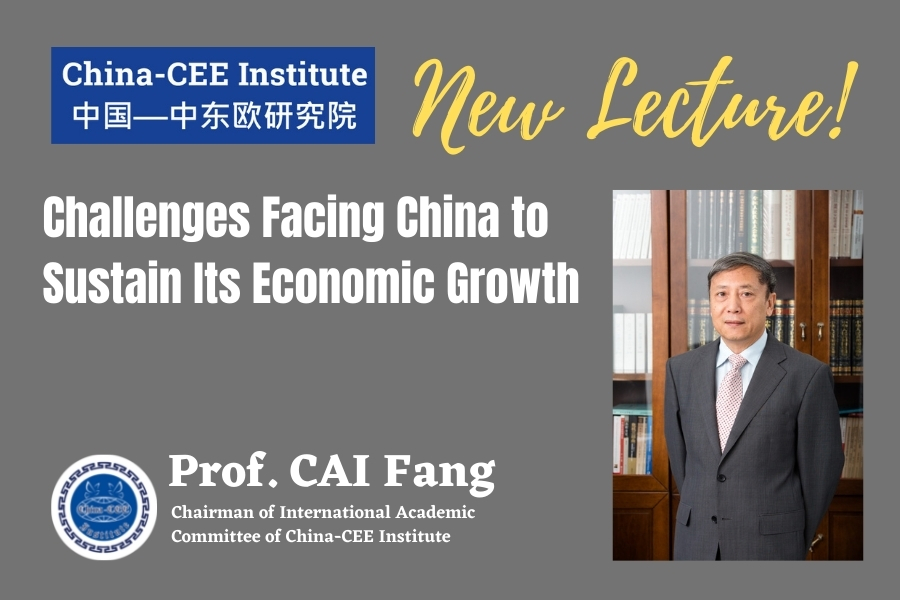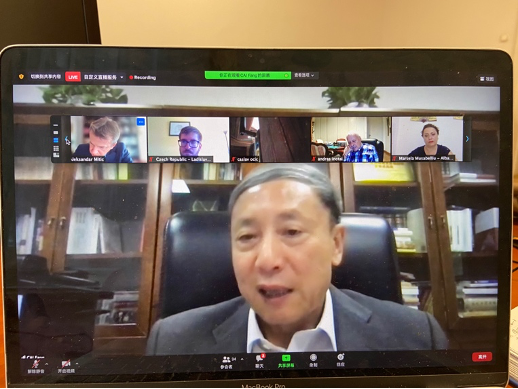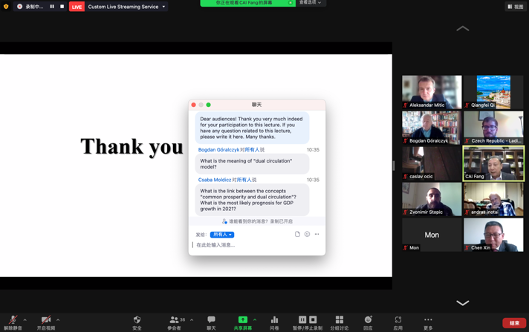On 22 September 2021, the China-CEE Institute invited professor CAI Fang, from the Chinese Academy of Social Sciences, to deliver a lecture on Challenges Facing China to Sustain Its Economic Growth via Zoom.
Prof. CAI is the chief expert of National Think Tank and Academician of the CASS and a member of the Standing Committee and Vice Chairman of the Agricultural & Rural Affairs Committee of the 13th National People’s Congress of China. His research interests focus on China’s economic reform and development, population economics, labor economics and poverty. His recent publications include Demystifying the Economic Growth in Transition China, and China’s Economic Development and Its Implications for the World. Prof. CAI is also the Chairman of International Academic Committee of the China-CEE Institute.

Professor CHEN Xin, Executive President of the China-CEE Institute and Deputy Director of the Institute of European Studies at CASS, hosted the lecture. Members of International Academic Committee of the China-CEE Institute, including Professor András INOTAI, Senior Research fellow at the Institute of World Economics, Hungarian Academy of Sciences, Professor Bogdan Góralczyk, from the Centre for Europe at the University of Warsaw, and Professor Časlav Ocić, from Serbian Academy of Sciences and Arts, joined the lecture. In addition, China-CEE Institute’s non-resident researchers and members from partner institutes also attended the lecture.

Professor CAI Fang
Professor CAI summarized the 14th Five-Year Plan (2021-2025) for National Economic and Social Development and the Long-Range Objectives Through the Year 2035 by introducing four “New Rhetoric”, namely, a new development stage from building a well-off society in an all-round way to building a modern socialist country in an all-round way; a new development goal of becoming a high-income country by 2025 and a moderately developed country by 2035; a new development philosophy of innovation, coordination, greenness, openness and sharing; and a new development pattern in which domestic and international circulation fosters each other while with the domestic market as the mainstay.
According to Professor CAI, two turning points of demographic transition, working age population peak that led to supply shock on economic growth and total population peak that will lead to demand shock on economic growth, will exert impact on China’s growth sustainability. This is because the former turning point weakens labor, human capital, physical capital formation and productivity, which reduces supply-side growth potential, and the latter turning point impacts export, investment, and consumption, which tends to weaken demand factors that are required by realizing potential.

During the lecture
To achieve the “14th Five-Year Plan” and 2035 long-term goals, we must avoid falling into the “middle income trap”. To this end, China needs to make efforts on both sides of supply and demand. On the supply side, China must continue to tap the potential for economic growth and strive to curb the decline in the growth potential on the supply side. For example, by removing barriers that hinder the flow of labor across industries, providing equal education and training opportunities, reforming the investment and financing system to prevent diminishing returns on capital, and allowing entrance-exit and survival-death of firms in order to enhance productivity. On the demand side, we must strive to cope with the export challenges brought about by the long-term global economic stagnation, the new coronavirus pandemic and de-globalization, as well as the impact of the decline in investment returns and the aging population on domestic investment and consumer demand.
Apart from the abovementioned arguments, professor CAI also talked about the role of “Common Prosperity”, including its key points, objectives and some countermeasures.
He concluded that, to realize its goals set for 2025 and 2035, China will have to tackle supply and demand challenges relating to the changes in development and population stages, and the 14th Five-Year Plan and 2035 Long-run Goal propose major reforms and programs that increase potential growth rate and share development outcomes more equally in order to expand domestic demand.

Q&A Session
During the second part of the lecture, professor CAI answered several questions from the participants. The questions include the meaning of “dual circulation” model, the link between common prosperity and dual circulation, the link between “dual circulation” and globalization, etc.
